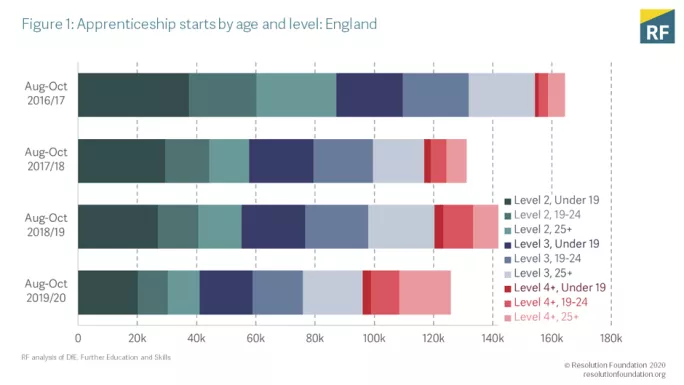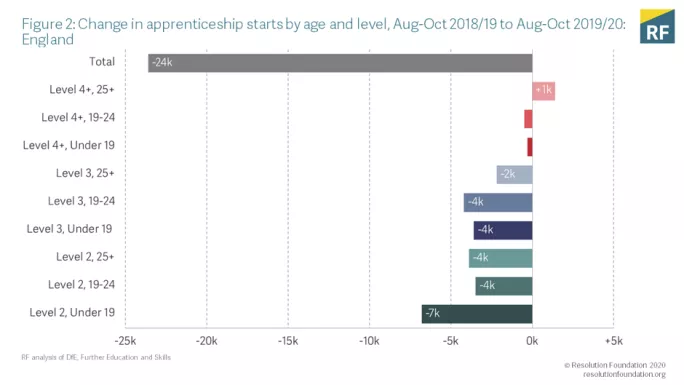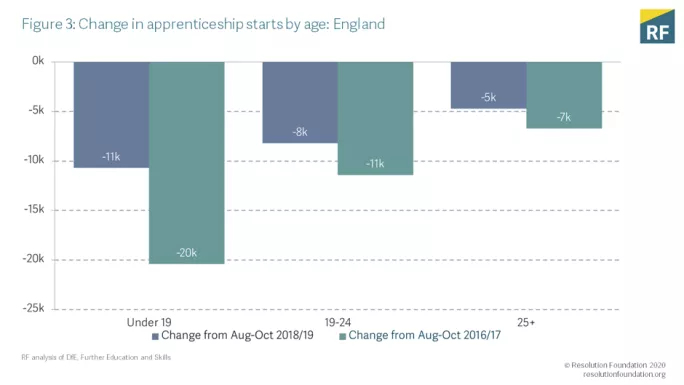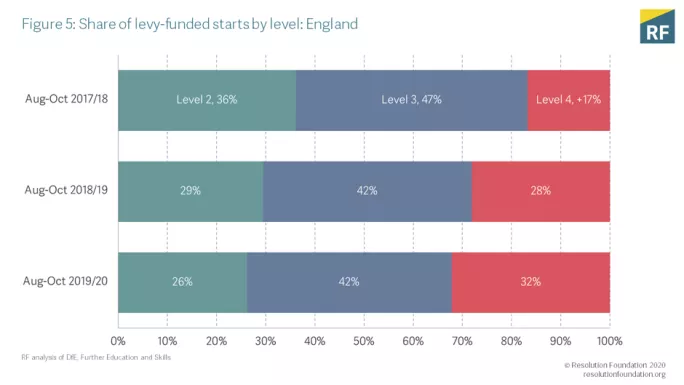
- Home
- ‘Our apprenticeships system offers fewer opportunities’
‘Our apprenticeships system offers fewer opportunities’

With a new year, a new-ish government and the country soon to (officially) exit the EU, there’s hope that policymakers will renew their focus on domestic concerns. And, given the figures published today showing an alarming fall in apprenticeship starts, a greater focus on this issue would be a good place to start.
The apprenticeship story post-levy and associated training rules coming into place during spring 2017 have resulted in an overall fall in the number of people starting an apprenticeship. The number of apprentices on lower-level programmes has fallen sharply, while the number of older (age 25+) apprentices on higher education-equivalent programmes has risen. This morning’s figures continue that trend, with some of the more worrying features of the system becoming even more prominent.
Revealed: The top 100 apprenticeship employers
Long read: The teacher who thought he was a psychopath
Opinion: Why is there still a stigma around apprenticeships?
So, what’s happened?
The drop in apprenticeship starts
First, the number of people starting an apprenticeship during the first quarter of this academic year (2019-20) is nearly 24,000 (16 per cent) less than the same period last year. This year-on-year fall is concerning. Many of us thought that the number of apprenticeship starts would stabilise once the recent reforms had bedded in. Instead, they’ve continued to fall.

Second, this fall has taken place across every level and age group bar one - older apprentices on higher education (level 4+) programmes. For instance, compared with this time last year, there were 7,000 fewer starts by 16- to 18 year-olds at level 2, 4,000 fewer starts by 19- to 24-year-olds at level 3, and 1,000 more starts by apprentices 25 and older at levels 4 and above.

Third, the picture for 16- to 18-year-olds - who are supposed to benefit most from the reforms - is particularly concerning. The fall in starts this year compared with the first quarter of 2016-17 (before the levy came in) was 20,000 - nearly three times as large as the fall in starts among those 25-plus (7,000).

And fourth, a large majority of apprenticeship starts (63 per cent overall) were funded by levy-paying employers including - for the first time - a majority (51 per cent) of starts at level 2. From a learning and outcomes point of view (ie, how much apprentices learn and how well we can expect them to do in the labour market after completing their programme), the share of starts funded by the apprenticeship levy tells us very little.

However, if we look at the type of apprenticeship that levy-paying employers invest their funds in (see Figure 5), it becomes clear that they are increasingly fixated on higher-education level programmes, and less so on programmes at levels 2 and 3. While the proportion of levy-funded starts at these levels has fallen, it has nearly doubled - from 17 to 32 per cent - for level 4 starts.

Given that levy-paying employers increasingly dominate the apprenticeship system, a continuation of these trends could - over the medium- to long-term - herald an apprenticeship system where nearly all training occurs at higher education levels.
Taking a step back, the picture this morning is of an apprenticeship system that offers fewer opportunities in the round - especially for young people looking to develop the skills required for a good career. Reasonable people can disagree on whether the only area of apprenticeship growth - older apprentices on higher-education programmes - is a good thing: to some, these figures represent adults with lower-level qualifications being offered the chance to progress their education; to others, it looks like already highly-qualified professionals taking advantage of a state-subsidised Master’s degree.
Overall, these figures highlight a worrying direction for apprenticeships. So here are four steps the government could take to address this:
- First, don’t idealise the past: while the pre-2017 apprenticeships system was certainly bigger than today’s, older apprentices still formed a plurality of starters - just at lower levels of study. Most apprentices were pre-existing employees (as opposed to new starts), formal training hours were low and roughly one-third of apprentices were unaware of the fact that they were an apprentice.
- Second, don’t thow the baby out with the bathwater: the training reforms that came in alongside the levy, such as requiring apprentices to spend 20 per cent of their time on off-the-job training and go through a formal end-point assessment, have helped to drive out programmes that offered little training and support.
- Third, clarity helps: by making public information that sets out the types of programmes that are growing, and the types of apprentices that are on them (ie, what share are new starters to their firm? What proportion will be raising their qualification level?), we can have a better sense of what England’s apprenticeships system funds: new career pathways or continuing professional development.
- And fourth, develop policy that elevates the former over the latter. Apprenticeships should offer young people and new starters a clear, quality route to the skills required for a good career. Getting there requires policymakers to hold firm on training, inspection and assessment requirements, while also altering funding rules so that firms are more strongly incentivised to open up routes for young people and new starters.
It’s not too late to set the system on a better course, but the longer it takes, the greater the number of young people and those in need of a new start who will lose out.
Kathleen Henehan is research and policy analyst at the Resolution Foundation
Register with Tes and you can read five free articles every month, plus you'll have access to our range of award-winning newsletters.
Keep reading for just £4.90 per month
You've reached your limit of free articles this month. Subscribe for £4.90 per month for three months and get:
- Unlimited access to all Tes magazine content
- Exclusive subscriber-only stories
- Award-winning email newsletters
You've reached your limit of free articles this month. Subscribe for £4.90 per month for three months and get:
- Unlimited access to all Tes magazine content
- Exclusive subscriber-only stories
- Award-winning email newsletters



